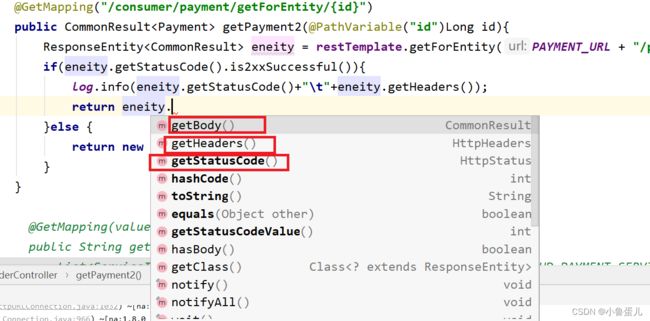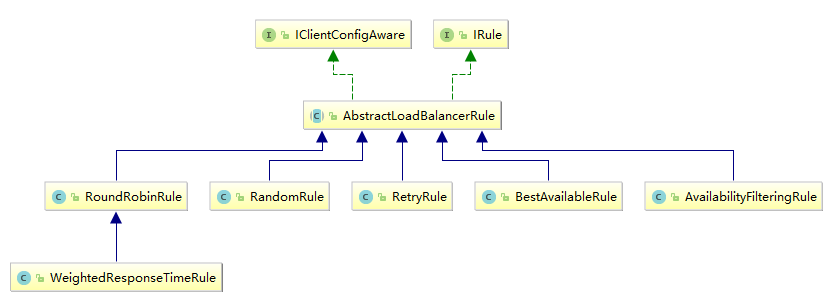SpringCloud学习笔记(五) Ribbon 负载均衡服务调用
目录
一、Ribbon简介
1、是什么
2、官网资料
3、能干吗
二、Ribbon负载均衡演示
1、架构说明
2、pom说明
3、二说RestTemplate的使用
三、Ribbon核心组件IRule
1、IRule接口实现类说明
2、Ribbon负载规则替换
四、Ribbon负载均衡算法
1、原理
2、ribbon源码
3、手写负载均衡器
一、Ribbon简介
1、是什么
Spring Cloud Ribbon是基于Netflix Ribbon实现的一套客户端负载均衡的工具。
简单的说,Ribbon是Netflix发布的开源项目,主要功能是提供客户端的软件负载均衡算法和服务调用。Ribbon客户端组件提供一系列完善的配置项如连接超时,重试等。简单的说,就是在配置文件中列出Load Balancer(简称LB)后面所有的机器,Ribbon会自动的帮助你基于某种规则(如简单轮询,随机连接等)去连接这些机器。我们很容易使用Ribbon实现自定义的负载均衡算法。
2、官网资料
https://github.com/Netflix/ribbon/wiki/Getting-Started
Ribbon目前也进入维护模式 https://github.com/Netflix/ribbon
未来替换方案
3、能干吗
LB负载均衡(Load Balance)是什么?
简单的说就是将用户的请求平摊的分配到多个服务上,从而达到系统的HA(高可用),常见的负载均衡有软件Nginx,LVS,硬件 F5等
Ribbon本地负载均衡客户端 VS Nginx服务端负载均衡区别?
- Nginx是服务器负载均衡,客户端所有请求都会交给nginx,然后由nginx实现转发请求。即负载均衡是由服务端实现的
- Ribbon是本地负载均衡,在调用微服务接口时候,会在注册中心上获取注册信息服务列表之后缓存到JVM本地,从而在本地实现RPC远程服务调用技术
集中式LB
即在服务的消费方和提供方之间使用独立的LB设施(可以是硬件,如F5, 也可以是软件,如nginx), 由该设施负责把访问请求通过某种策略转发至服务的提供方
进程内LB
将LB逻辑集成到消费方,消费方从服务注册中心获知有哪些地址可用,然后自己再从这些地址中选择出一个合适的服务器。Ribbon就属于进程内LB,它只是一个类库,集成于消费方进程,消费方通过它来获取到服务提供方的地址
一句话
负载均衡+RestTemplate调用
二、Ribbon负载均衡演示
1、架构说明
Ribbon在工作时分成两步:
第一步先选择 EurekaServer ,它优先选择在同一个区域内负载较少的server
第二步再根据用户指定的策略,从server取到的服务注册列表中选择一个地址;其中Ribbon提供了多种策略:比如轮询、随机和根据响应时间加权
总结:Ribbon其实就是一个软负载均衡的客户端组件,他可以和其他所需请求的客户端结合使用,和eureka结合只是其中的一个实例。
2、pom说明
之前写样例时候没有引入spring-cloud-starter-ribbon也可以使用ribbon
猜测spring-cloud-starter-netflix-eureka-client自带了spring-cloud-starter-ribbon引用,
证明如下: 可以看到spring-cloud-starter-netflix-eureka-client 确实引入了Ribbon
3、二说RestTemplate的使用
官网
https://docs.spring.io/spring-framework/docs/5.2.2.RELEASE/javadoc-api/org/springframework/web/client/RestTemplate.html
getForObject方法/getForEntity方法
getForObject方法:返回对象为响应体中数据转化成的对象,基本上可以理解为Json
getForEntity方法:返回对象为ResponseEntity对象,包含了响应中的一些重要信息,比如响应头、响应状态码、响应体
加到 cloud-consumer-order80 的controller类里
@GetMapping("/consumer/payment/getForEntity/{id}")
public CommonResult getPayment2(@PathVariable("id")Long id){
ResponseEntity eneity = restTemplate.getForEntity(PAYMENT_URL + "/payment/get/" + id, CommonResult.class);
if(eneity.getStatusCode().is2xxSuccessful()){
log.info(eneity.getStatusCode()+"\t"+eneity.getHeaders());
return eneity.getBody();
}else {
return new CommonResult<>(444,"操作失败");
}
} 测试
postForObject方法/postForEntity方法
GET请求方法
T getForObject(String url, Class responseType, Object... uriVariables);
T getForObject(String url, Class responseType, Map uriVariables);
T getForObject(URI url, Class responseType);
ResponseEntity getForEntity(String url, Class responseType, Object... uriVariables);
ResponseEntity getForEntity(String url, Class responseType, Map uriVariables);
ResponseEntity getForEntity(URI var1, Class responseType); POST请求方法
T postForObject(String url, @Nullable Object request, Class responseType, Object... uriVariables);
T postForObject(String url, @Nullable Object request, Class responseType, Map uriVariables);
T postForObject(URI url, @Nullable Object request, Class responseType);
ResponseEntity postForEntity(String url, @Nullable Object request, Class responseType, Object... uriVariables);
ResponseEntity postForEntity(String url, @Nullable Object request, Class responseType, Map uriVariables);
ResponseEntity postForEntity(URI url, @Nullable Object request, Class responseType); 三、Ribbon核心组件IRule
1、IRule接口实现类说明
IRule:根据特定算法中从服务列表中选取一个要访问的服务
- com.netflix.loadbalancer.RoundRobinRule:轮询
- com.netflix.loadbalancer.RandomRule:随机
- com.netflix.loadbalancer.RetryRule:先按照RoundRobinRule的策略获取服务,如果获取服务失败则在指定时间内会进行重试,获取可用的服务
- WeightedResponseTimeRule:对RoundRobinRule的扩展,响应速度越快的实例选择权重越大,越容易被选择
- BestAvailableRule:会先过滤掉由于多次访问故障而处于断路器跳闸状态的服务,然后选择一个并发量最小的服务
- AvailabilityFilteringRule:先过滤掉故障实例,再选择并发较小的实例
- ZoneAvoidanceRule:默认规则,复合判断server所在区域的性能和server的可用性选择服务器
2、Ribbon负载规则替换
修改cloud-consumer-order80
注意配置细节
官方文档明确给出了警告:
这个自定义配置类不能放在@ComponentScan所扫描的当前包下以及子包下,否则我们自定义的这个配置类就会被所有的Ribbon客户端所共享,达不到特殊化定制的目的了。
新建package
com.atguigu.myrule
新建MySelfRule规则类
@Configuration
public class MySelfRule {
@Bean
public IRule myRule(){
return new RandomRule();//定义为随机
}
}主启动类添加@RibbonClient
@SpringBootApplication
@EnableEurekaClient
@RibbonClient(name = "cloud-payment-service",configuration = MySelfRule.class)
public class OrderMain80 {
public static void main(String[] args) {
SpringApplication.run(OrderMain80.class,args);
}
}四、Ribbon负载均衡算法
1、原理
负载均衡算法:rest接口第几次请求数 % 服务器集群总数量 = 实际调用服务器位置下标 ,每次服务重启动后rest接口计数从1开始。
List instances = discoveryClient.getInstances("CLOUD-PAYMENT-SERVICE");如:
List [0] instances = 127.0.0.1:8002
List [1] instances = 127.0.0.1:80018001+ 8002 组合成为集群,它们共计2台机器,集群总数为2, 按照轮询算法原理:
当总请求数为1时: 1 % 2 =1 对应下标位置为1 ,则获得服务地址为127.0.0.1:8001
当总请求数位2时: 2 % 2 =0 对应下标位置为0 ,则获得服务地址为127.0.0.1:8002
当总请求数位3时: 3 % 2 =1 对应下标位置为1 ,则获得服务地址为127.0.0.1:8001
2、ribbon源码
com.netflix.loadbalancer.RoundRobinRule类
public Server choose(ILoadBalancer lb, Object key) {
Server server = null;
int count = 0;
while (server == null && count++ < 10) {
List reachableServers = lb.getReachableServers();
List allServers = lb.getAllServers();
int upCount = reachableServers.size();
int serverCount = allServers.size();
int nextServerIndex = incrementAndGetModulo(serverCount);
server = allServers.get(nextServerIndex);
if (server == null) {
/* Transient. */
Thread.yield();
continue;
}
if (server.isAlive() && (server.isReadyToServe())) {
return (server);
}
// Next.
server = null;
}
if (count >= 10) {
log.warn("No available alive servers after 10 tries from load balancer: " + lb);
}
return server;
}
private int incrementAndGetModulo(int modulo) {
for (;;) {
int current = nextServerCyclicCounter.get();//获取原子的值
int next = (current + 1) % modulo;
if (nextServerCyclicCounter.compareAndSet(current, next)) //CAS
return next;
}
}
3、手写负载均衡器
80端实现轮询
接口:从服务列表选出一台机器进行访问
public interface LoadBalancer {
/**
* 从服务列表选出一台机器进行访问
* @param serviceInstances 服务列表
* @return
*/
ServiceInstance instances(List serviceInstances);
} 实现类
@Component
public class MyLB implements LoadBalancer{
private AtomicInteger atomicInteger = new AtomicInteger(0);
public final int getAndIncrement(){
int current;
int next;
do{
current = this.atomicInteger.get();
next = current >= Integer.MAX_VALUE ? 0 : current+1;
}while (!this.atomicInteger.compareAndSet(current,next));
//atomicInteger.compareAndSet(expect, update),
//比较except和update,如果相等返回true,否则返回fasle
System.out.println("*********第"+next+"次访问");
return next;
}
@Override
public ServiceInstance instances(List serviceInstances) {
int index = getAndIncrement() % serviceInstances.size();
return serviceInstances.get(index);
}
} 消费方80controller类加上自己实现的轮询方法
@Slf4j
@RestController
public class OrderController {
@Resource
private LoadBalancer loadBalancer;
@GetMapping(value = "/consumer/payment/lb")
public String getPayment(){
//获得服务列表
List instances = discoveryClient.getInstances("CLOUD-PAYMENT-SERVICE");
if(instances == null || instances.size()<=0){
return null;
}
ServiceInstance serviceInstance = loadBalancer.instances(instances);
URI uri = serviceInstance.getUri();
log.info(" "+uri);
return restTemplate.getForObject(uri+"/payment/lb",String.class);
}
}
服务提供者8001,8002controller加上80端调用的方法
@GetMapping(value = "/payment/lb")
public String getPayment(){
return serverPort;
}注意:测试的时候注释掉这两个注释,不然 restTemplate.getForObject不知道调用哪个服务,报错如下,从报错描述可知没有合适的调用对象。












